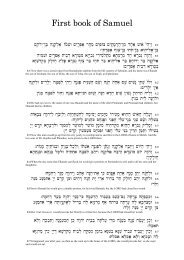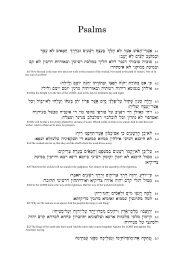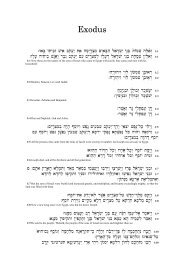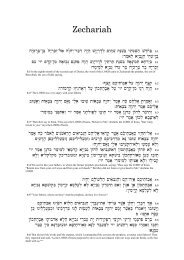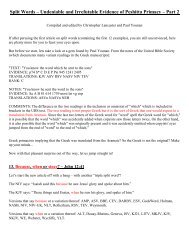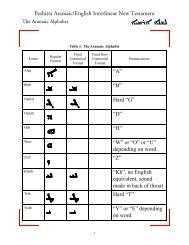ana translation
Untitled - Peshitta Aramaic/English Interlinear New Testament
Untitled - Peshitta Aramaic/English Interlinear New Testament
- No tags were found...
Create successful ePaper yourself
Turn your PDF publications into a flip-book with our unique Google optimized e-Paper software.
INTRODUCTION<br />
lix<br />
Krpiov (Jud. 4).<br />
On the whole, however, it leans decidedly to the<br />
B-side. If it is rightly assigned, as Mrs. Gibson with other authorities<br />
of the highest competence assign it on palaeographic grounds, to the<br />
ninth century, it is, as a witness in great measure to the B-text, coeval<br />
with our oldest witness to the A-text (Cod. 1).<br />
And thus it proves<br />
that many of the most serious corruptions of the B-text are not, as the<br />
MS evidence would otherwise lead us to conclude, recent in date and<br />
Maronite in origin.<br />
SECTION XV.<br />
The Text of the Earlier as against the Later MSS<br />
adopted in this Edition.<br />
From the materials described in the foregoing Section the text of<br />
the present Edition has been formed, irrespective of all previous printed<br />
texts. All those texts are based ultimately, as we have seen, oil two<br />
manuscripts one, our Cod. 8, the other not now forthcoming, which<br />
are reproduced, the former in the Editio Princeps, the latter in the<br />
Paris Polyglot ;<br />
the former being (see p.<br />
liv supr.) of the seventeenth<br />
century, the latter nearly identical with it in text, and probably little<br />
if at all earlier in date. One or other of these has been assumed as the<br />
two only of whom (both of the<br />
Textus Beceptus by subsequent editors ;<br />
nineteenth century) have corrected it here and there Dr. Lee in L<br />
after Cod. 9, and the American editor in N, after Cod. 11.* The text<br />
of all these, even of L and N, presents a considerable number of readings<br />
which diverge widely from the text of the original as attested by Greek<br />
authorities, most of these divergences being unconfirmed by any other<br />
evidence. Many, but not all, of these divergent readings<br />
have been<br />
made known to Biblical students in the Apparatus subjoined to Tischendorf's<br />
Greek Testament (eighth edition). f<br />
The text as now presented,<br />
based on the combined testimony of some twenty manuscripts, varying<br />
in date from the ninth century to the seventeenth or later (including<br />
every one which I have been able directly or indirectly to reach), and<br />
thus completely reconstructed, will be found to differ frequently in<br />
not a few places materially from the text as hitherto edited. The<br />
* See p. Ivii supr.<br />
t Tischendorf cites the Syriac New Testament from Schaaf's edition (or rather<br />
from the Latin version attached to its text) as "Syr' ch " except in the Four<br />
Epistles, where he writes " Syr bodl " ; assuming Schaaf to have uniformly repeated<br />
Pococke's text, which is not always the fact. See my article in Hcrmathena-,<br />
vol. vii, pp. 281 et sgg.



